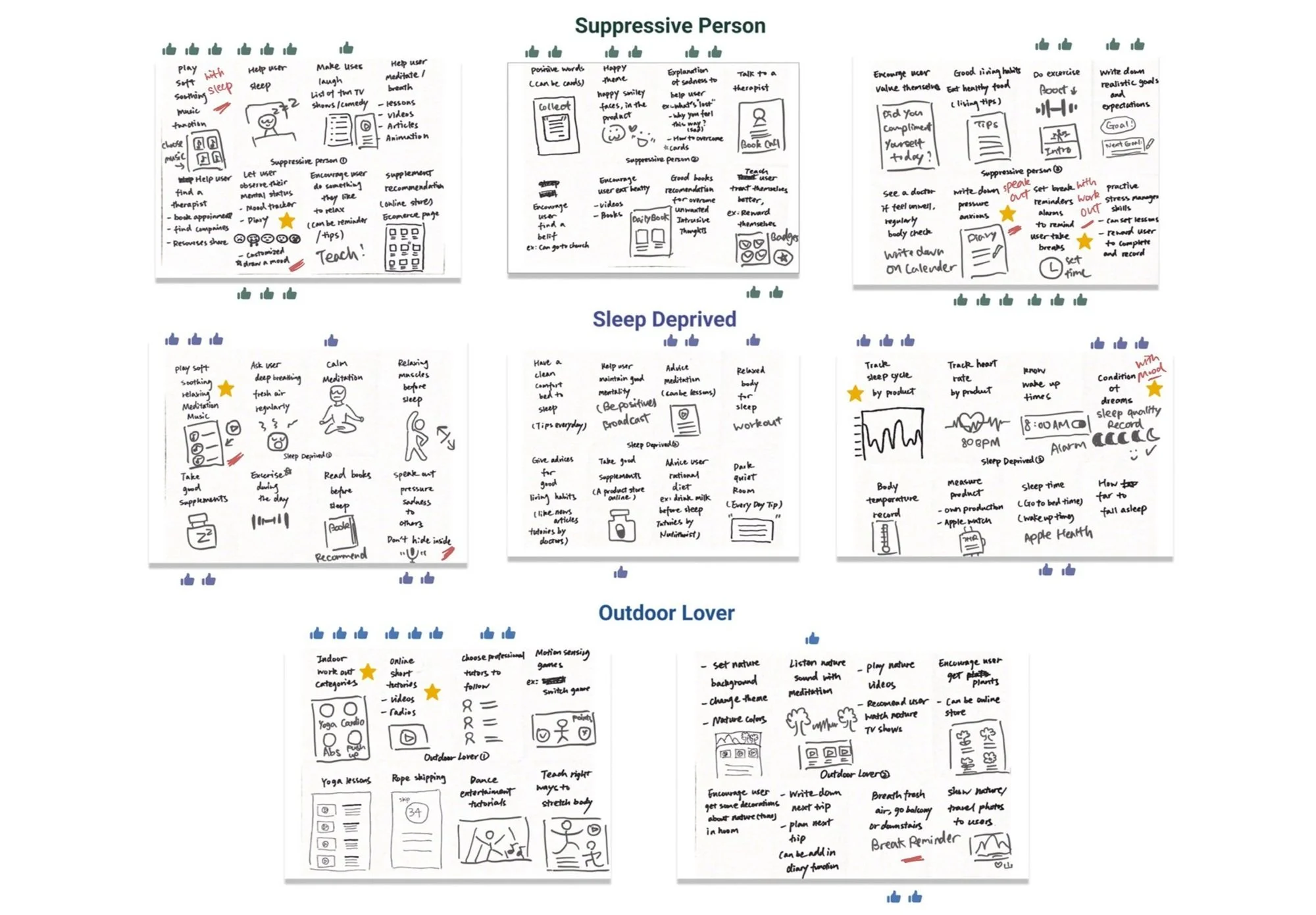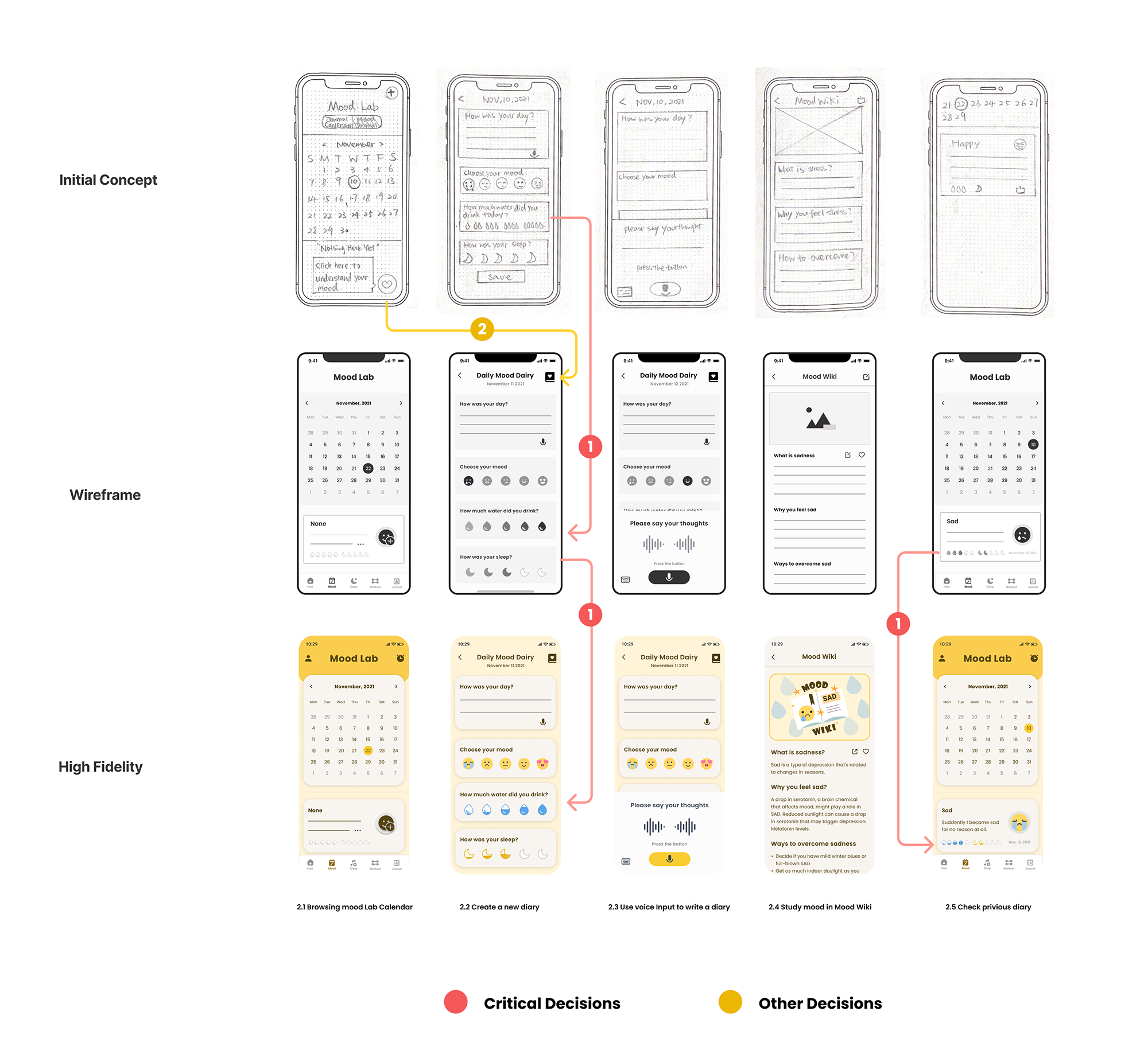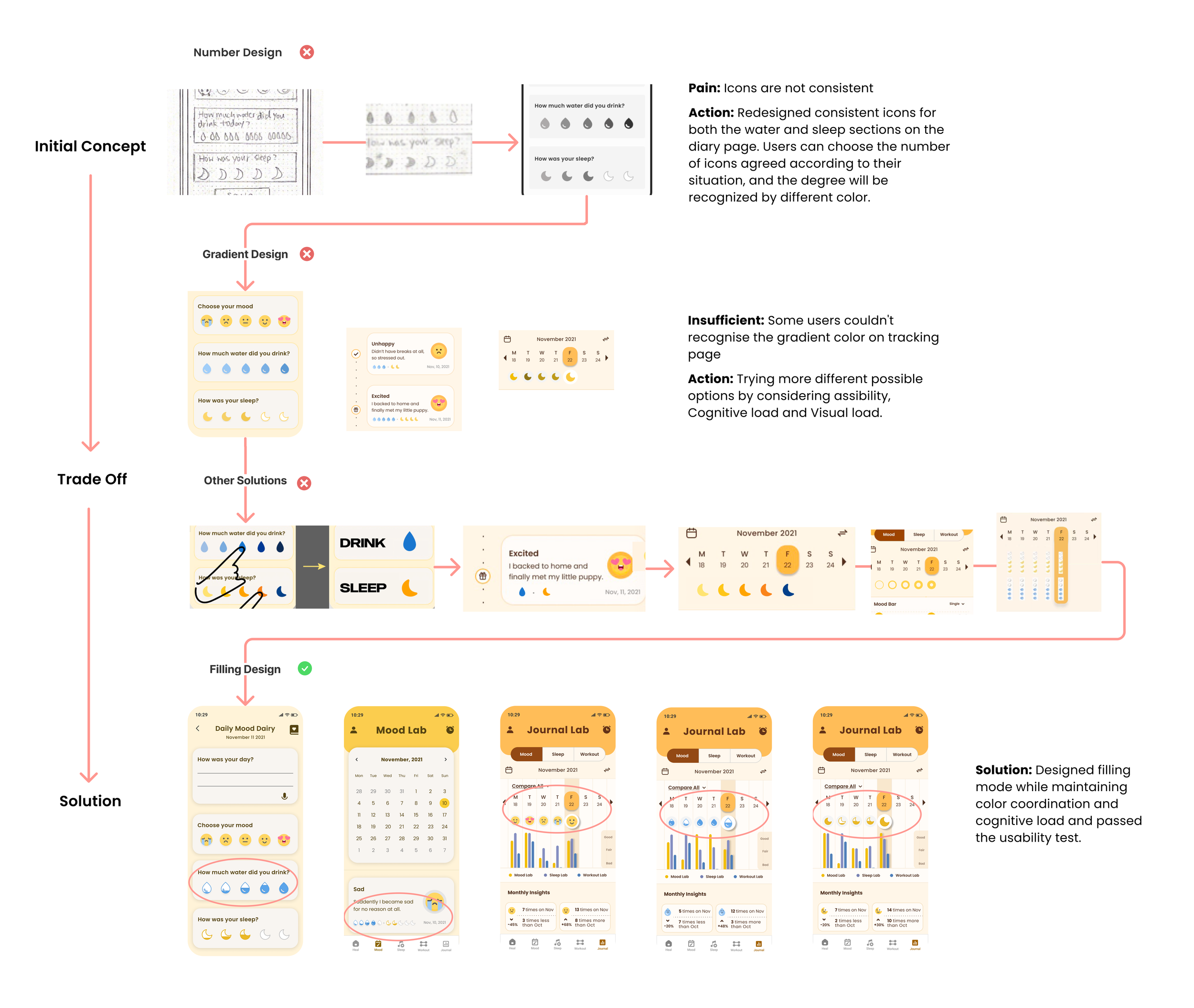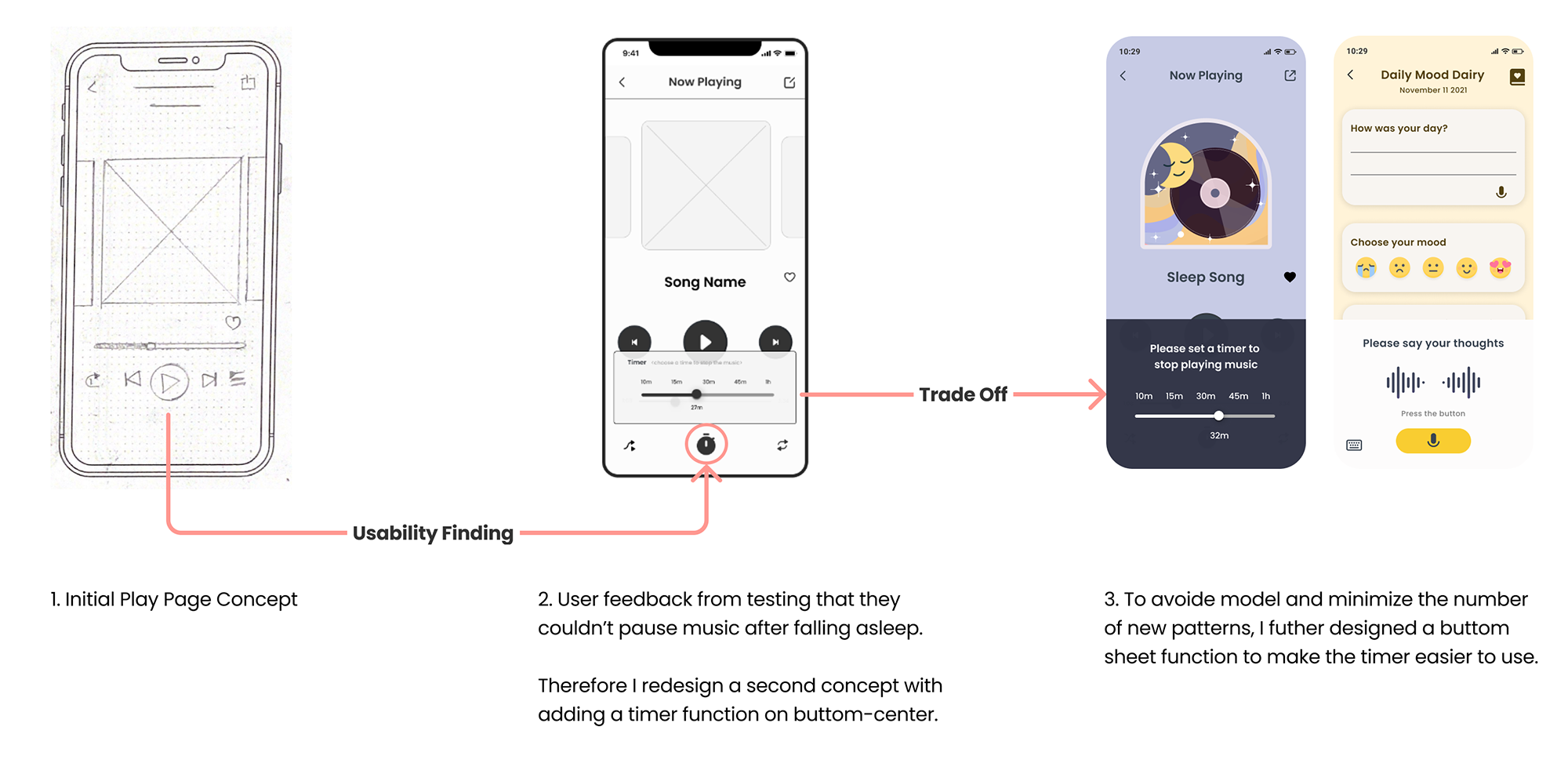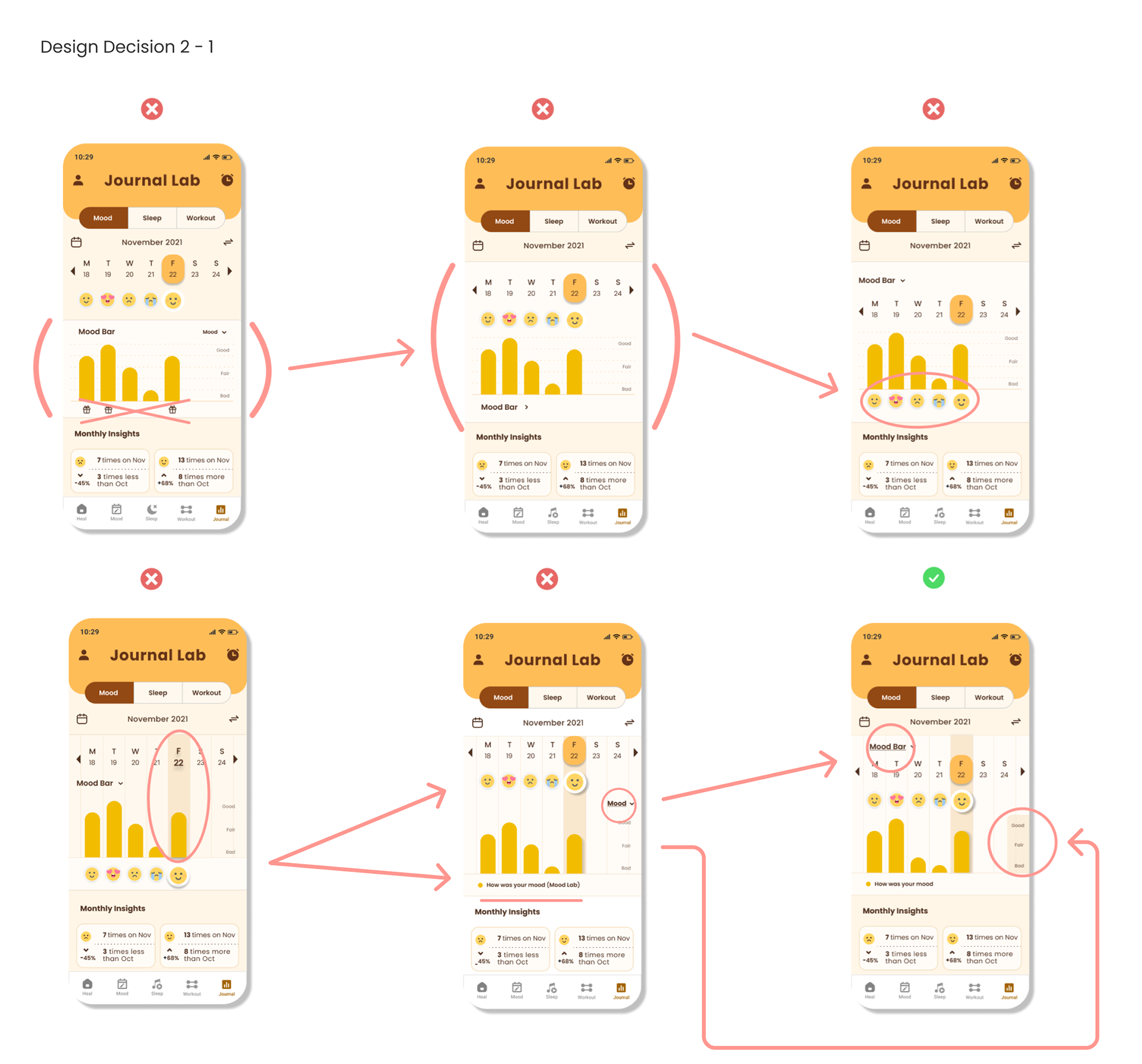Healing Lab Mental Health App
Healing Lab is a mobile app that helps individuals' mental health by managing stress at work and relieving stress practices. It allows users to track and compare their health data to self-manage and recognize their mental states.
Tools
Figma, Miro, Mural, Illustrator, Photoshop
Scope
Research, UI/UX Design, Illustrations
Project Info
Individual Project
During the pandemic, 93% of healthcare workers faced severe stress and burnout, leading to a 23.8% increase in resignations. They are seeking a mental health solution.
D E S I G N S O L U T I O N O V E R V I E W
History Tracking
People suffering from moderate to high stress
44% reported increased stress levels over the past five years. More than 77% say the future of the nation is a significant source of stress up significantly from 2019.
“Sadly, only a small percentage of people actively seek professional help for their mental health problems.”
R E S E A R C H
Secondary Research
Pandemic Attack
A persistent spiritual battle that the world is caught off guard
In a survey of essential workers, research suggests that over 50% of doctors, nurses, and emergency responders could be at risk for one or more mental health problems during the pandemic.
Competitive Analysis
Potential Impact
When stress brings death
Stress can cause headaches, high blood pressure, heart disease, diabetes, depression, anxiety, etc. According to statistics, work stress, such as long hours and job strain, is a leading cause of suicide among Americans.
To get familiar with potential app users, I analyzed the current market and our prior competitors: Headspace, Calm, Motivation, Stoic, and Daylio. Some of the key insights I found below were:
Primary Research With Medical Workers
After doing secondary research, I interviewed six medical workers who had been working in the hospital during the pandemic. Here are some major takeaways:
I utilized an affinity map(a link) and an empathy map(a link) to help me map out and organize all notions. Some key points from the interviewers that set the stage for my next identification steps:
No Breaks during the work
Often feel stressed out, anxious, and depressed
Unable to fall asleep quickly and can’t sleep well
Don’t have time to have a personal life and anticipate outside activities
Compared with counseling therapists, they are more inclined to self-digest their troubles
User Personas
With all the interview data findings at hand, I was able to draft three personas to help me clarify different types of potential users and targeted users’ pain points, motivations, and needs.
Tracing Answers From Professionals
While interviewing and discovering problems, I also got feature suggestions and inspiration from my interviewees (health workers) referred decompression methods and knowledge of professional treatment. Therefore, I returned to the affinity map and put together all the solution ideas.
Dialectical behavioral therapy (DBT)
Pay attention when emotions are caught in a negative cycle
Plan positive goals ahead
Speak out and communicate needs
Accept the current situation
Psychotherapy Study
From my primary research, another critical problem I found was that my users are very busy talking to therapists and more inclined to self-regulate stress. To this end, I further studied the knowledge of psychiatry and sought professional methods of self-regulation advocated by experts. These authoritative methods will help me ideate solutions to help users effectively self-regulate mental problems and maintain a good mental state.
Cognitive-behavioral therapy (CBT)
Change your perspective of the problem
Improve self-talk by recording emotions and thoughts
Medical Monitoring and Management Study
8 Crazy Methods
Acceptance and Commitment Therapy(ACT)
Positive behavior change is only possible if we know how specific behaviors affect us.
Open up to negative emotions, learn not to overreact, and develop a positive mindset.
Subjective data & Objective data
In nursing, understanding the difference between subjective and objective data can be critical in taking note of the situation and dealing with it with utmost efficacy.
“Re-Review With Professionals”
After gathering all the insight ideas, I used crazy 8s brainstorming to produce practical ideas for better solutions. During the process, I reviewed with my professional interviewees to ensure the solutions were executable. Then I asked them to vote on their favorite features. The user feedback helped me filter and narrow down my focus points.
Last, to better plan out the order of features, I prioritized answers from “Must Have” to “Surprising & Delightful” based on user choices.
The Similarity & Differences
To further verify the answer and identify product differences and features, I re-evaluated and studied the most popular analogous competitors with my solutions again. This allows me to review my product features and again compare competitor strengths.
S E T T H E B U S I N E S S G O A L & B R A N D I N G
The Mission
With the brainstormed results, I summarized end-user goals from my research and business goals to clarify the project vision and priorities. The technical aspect is another involved party with goals to create a smooth functioning app and a user-friendly platform.
Story & Branding
As a mental health app, brand experience and user experience are expected to work together to engage and delight customers to keep the user stickiness.
“The idea behind this product is to make users feel fun as doing experiments.”
To build emotional connections with my user, I took advantage of color theory & mental health science to make the most storytelling product-to-brand product features.
Site Map
To start creating the app, I designed a site map to plan and build the structure and flow of this product.
User Flow
Next, I further visualized the process, and the path based on the feature score chart users can follow to achieve different goals.
Develop By Scenarios
I invited seven medical workers as participants to conduct usability tests using moderated and unmoderated testing methods. We went through five scenarios, from the initial concept to continuous usability testing with users to re-improvement and ultimately develop the final result.
Due to the pandemic, usability tests were conducted online.
Scenario One: Healing Lab Home Page
Users can check their usage progress on the home page, do basic mental exercises, and set rest reminders for the day, then directly click on the recommended practice of the day through the home page.
Critical Decision 1: Use At First Glance
User Goal : Balance workflow and remind themself to take a breath during busywork
A crucial problem is health workers are too busy to adjust their working schedule and try to get breaks. So how to help users design the most convenient way to use a break reminder at work? I observed users took many actions to use this function through usability tests, which is not feasible in the working environment. Thus I upgraded and reduced user clicks by the following process:
Scenario Two: Mood Lab Diary Page
For users who often feel stressed and anxious they expect to speak out their minds and record their moods to relieve stress and understand their mental state.
Critical Decision 1: Reducing My Users Content Burden
User Goal: Record mood and clearly understand their state from the record
To let users have a more comprehensive understanding of their state, they can quickly select their mood, water amount, and sleep quality. I found I needed to think from three perspectives: accessibility, usability, and visual appeal(aesthetics) to help users recognize what they chose on the diary page, mood card, and tracking section as well. I got the final solution through different design schemes and trade-offs:
Other Decisions 2
Mood Wiki is a newly developed feature. Due to the absence of reference data, I thought about how to make it most effective to help users learn their mood while designing the user flow. Therefore, I created two solutions according to two scenarios and tested which is more feasible using A/B testing. As a result, more users picked scenario 2.
Scenario Three: Sleep Lab Music Page
Users who are unable to fall asleep due to stress want to decompress before going to bed to help sleep.
Critical Decision 1: Have a calm sleep with a customized music timer
User Goal: Relief stress before sleep and be able to fall asleep faster.
Scenario Four: Workout Lab Training Page
For outdoor lovers who are too busy to go out to exercise. They are seeking self-decompression training after getting off work.
Critical Decision 1: Easy Excercise Training
User Goal: Get some exercise to relieve stress after getting off work
To solve the problem that outdoor enthusiasts cannot exercise due to their busy work, I have been thinking about how to make training functions that are convenient and fast while allowing them to do decompression exercises by following decisions:
Scenario Five: Journal Lab Tracking Page
During the use of various functions of the Healing Lab, users await to track their behavioral health data and learn more about their mental state to further self-regulate.
Critical Decision 1: Help users understand how different areas of their life impact each other
User Goal: Have a clear and comprehensive understanding of their mental states and learn to self-regulate.
Addressing another critical concern involves enhancing users' ability to effectively monitor and document their mental symptoms and trends over time. Initially, my solution focused solely on tracking mood diary data. However, user feedback requesting more comprehensive insights prompted the development of an advanced tracking system. A moment of research insight struck: "What synergies emerge when objective data intersects with subjective data?" This led to incorporating sleep and workout patterns, integrated through the Apple Health API, to facilitate comparison. Mood data forms the subjective database, while sleep and exercise data constitute objective metrics. Ultimately, this approach aids users in comprehending the interconnectedness of these datasets and how they influence one another.
Critical Decision 2: Minimize user cognitive load & visual load to maximize usability
User Goal: Able to compare and understand how different data impact each other at a glance
To help users use the new tracking function more easily. How to minimize user cognitive load and visual load in multi-information situations due to adding more information and comparison was another key challenge for me. I came up with the final solution and passed user testing through the following constant revisions and decisions:
In order to reduce user learning and understand the information more clearly, I have added explanations to each page.
After the test, I asked users for feedback using the CSAT survey. Although Healing Lab is a personal project, this process has given me insight into potential user satisfaction levels, feedback, and opinions on this product.
R E F L E C T I O N
What I’ve learned
Embarked on an uncharted journey in my first mental health project, necessitating a blend of user-centered design and safety considerations.
Specifically targeted healthcare workers as my user base, a privilege that exposed me to their unique challenges and needs.
Conducted in-depth interviews and discussions with healthcare professionals, gaining profound insights into their daily experiences and struggles as well as psychotherapy.
Employed a user-centered design approach to empathize with their pain points, motivations, emotions, and requirements.
Actively sought and incorporated feedback, aiming for precision and effectiveness in my designs.
Achieved positive reviews and significant personal growth, with a newfound knowledge of mental illness and a deeper understanding of psychotherapy practices as valuable takeaways from the project.
What I would do differently
Due to the pandemic, most interviews and tests were held online. Therefore, in the process of conversation, there was a lack of face-to-face truth revealing, which is unfortunate, especially for developing a mental health product. I would love to feel and see the presence of the other party to understand deeper their different thoughts and feedback if I do this again.


















